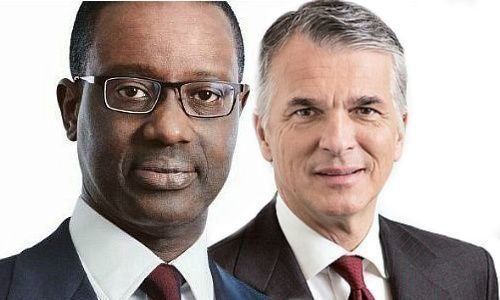Credit Suisse’s Light vs UBS Darkness
Credit Suisse emerged from a three-year restructuring with an unusually peppy outlook of its prospects. The view contrasts with doom and gloom from its rival, UBS.
«Cautiously optimistic» was how Credit Suisse put it: a booming end to the quarter continued this month, the bank’s pipeline of in wealth management and investment banking is full, markets are favorable, and clients are less worried about big-picture risks and more confident, which in theory feeds transactions.
«…a challenging January, a limited recovery in February followed by a strong March, which was our second-highest revenue month in the last 39 months», CEO Tidjane Thiam said, after reporting an 8 percent hike in quarterly profit. Investors responded well, sending the shares more than 3 percent higher in early trading.
Rhetorical Art Form
The buoyancy comes following a three-year restructuring and two cash calls to replenish capital. It stands in stark contrast with UBS, which has honed outlook guidance to a rhetorical art form.
In January, UBS posted a feeble fourth quarter and gave investors little hope things would improve. Then last month, CEO Sergio Ermotti effectively unleashed a profit warning at a brokerage conference.
The first quarter, traditionally the strongest in banking, was the toughest in years, Ermotti warned. «We've seen some improvement lately but it remains patchy, and not enough to offset the challenging start of the year», he said, just ten days before the quarter closed.
Credit Suisse's Secret?
So what is Credit Suisse doing right and UBS, which reports the quarter on Thursday, apparently doing wrong? One key difference is a major bloodletting: Thiam squeezed 6 percent spending cuts out of Credit Suisse last year, while Ermotti managed a negligible 0.2 percent at UBS.
As a result, Credit Suisse – with a cost-income ratio of 76.9 percent – is simply operating on a slightly more nimble basis than UBS, clunking along at nearly 80 percent. Ermotti, who is a Swiss native, has explicitly ruled out another major round of big job cuts at UBS – though it would be the quickest way to perk up the bank's margins.
The other key difference is Credit Suisse’s rollercoaster of trading and investment banking wins and losses. The bank bragged of its second-strongest month (March 2019) for overall revenue in 39 months. This came off a huge sequential boost from its markets unit, including Asia.
«Grab Bag» Unit
The trade-off is that Credit Suisse’s investment banking arm continues to be a grab bag: it wiped out in the last quarter of 2018 as well as 2017, not to mention its 2.2 billion Swiss franc loss in annus horribilis 2015. This quarter, not the trading arm but the securities and capital markets skidded.
Credit Suisse cited a 35-day U.S. government shutdown last year, investors fretting over growth slowing, and geopolitics in all its major markets. What that meant in practice was underwriting of stocks and bonds plummeted, mergers and acquisitions (and hence fees) fizzled, and loans were valued lower.
Investors Rewarded
By contrast, UBS had one slide in investment banking in the last two years (one quarter ago, when it lost $37 million). Shareholder payouts are another major difference: UBS has paid out roughly 50 percent, or more, since 2016.
Credit Suisse didn’t convert to cash dividends until 2017, following years of share-based awards, or so-called scrips. Thiam and Chairman Urs Rohner still haven’t pledged a ratio of profits to investors, as UBS did in its major 2011 restructuring.




























